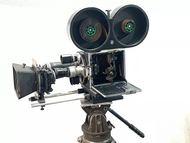From Hand-Cranked Beginnings to Digital Marvels: The 35mm Film Camera Evolution
Posted by Julio Urbay on 25th May 2025
The evolution of 35mm film cameras is a fascinating journey that mirrors the evolution of cinema itself. What started as humble, hand-cranked devices in the late 19th century has transformed into today's cutting-edge digital cinema systems. This blog explores the major milestones in the development of these cameras—from their early days to the modern era—highlighting the innovations that have shaped the movie theater experience we know and love.
Early Beginnings: The Birth of 35mm Film (1890s–1920s)
The story begins in the early 1890s with inventors like Thomas Edison and William Kennedy Dickson, who laid down the foundation by experimenting with 35mm film. Their early devices, including innovations like the Kinetoscope, introduced audiences to motion pictures on a flexible 35mm format—a format that proved ideal for balancing image quality with practical usability.
During these early days, film cameras were manually operated and produced short silent films at frame rates around 16 frames per second. Pioneers such as the Lumière brothers helped standardize the 35mm format, establishing it as the industry norm. As manufacturers like Bell & Howell refined the early designs, improvements in image stability and clarity set the stage for a new era in filmmaking.
The Sound Era Revolution (Late 1920s–1930s)
The late 1920s brought a monumental shift in the film industry with the introduction of synchronized sound. This innovation required major modifications to the existing 35mm film cameras. No longer sufficient to merely record moving images, cameras now had to ensure that audio was in perfect sync, a challenge that led to the adoption of motor-driven mechanisms and the standardization of 24 frames per second.
In addition to syncing sound, this era saw the emergence of better film sensitivity and improved lens quality. The technical upgrades during the sound era set a new benchmark for movie production, paving the way for Hollywood’s Golden Age and the expansive cinematic narratives that would follow.
The Golden Age of Hollywood (1930s–1960s)
As sound became an integral part of film, the mid-20th century witnessed rapid advancements in camera technology. The era of Hollywood’s Golden Age saw the rise of specialized film cameras such as the Mitchell BNC, as well as early versions from innovators like Arri and Panavision. These cameras were designed to capture not only high-quality images but also the enhanced visual textures of color film and widescreen formats.
Filmmakers during this time pushed the boundaries of creativity and storytelling, supported by equipment that delivered richer visuals and sharper details. As technology improved, the reliability of 35mm film cameras grew, cementing their role as the backbone of cinematic production for decades.
The Transition to Digital and Modern Adaptations (1970s–Present)
The later decades of the 20th century ushered in a period of transition. While 35mm film remained a beloved medium, the technological landscape began to shift with the introduction of digital sensors and more agile camera designs. The 1970s and 1980s saw more ergonomic cameras that enabled groundbreaking on-location filming, and the inherent challenges of film stock and optical engineering continued to be addressed with each passing year.
The early 2000s marked the digital revolution in cinematography. Although many filmmakers still appreciate the organic quality of 35mm film, the convenience and versatility of digital cameras have transformed the industry. Modern systems—like the ARRI Alexa and RED series—offer unparalleled resolution, dynamic range, and seamless integration with digital post-production workflows. This hybrid approach celebrates the legacy of 35mm while embracing the efficiencies of modern technology.
Legacy and Future Prospects
The rich history of 35mm film cameras is not just a chronicle of technological innovation—it is a dialogue between art and engineering. Every milestone in this evolution has defined how stories are told, experienced, and remembered in movie theaters worldwide. Even as digital technology redefines cinematic production, the lessons learned from the golden days of 35mm film continue to influence filmmakers who seek to capture the timeless aesthetics of analog film.
Looking ahead, the industry is poised for further innovation with digital tools that offer real-time editing, immersive visual effects, and even more versatile production capabilities. Yet, the warmth and character of 35mm film still hold a special place in the hearts of movie enthusiasts and directors. Whether through archival screenings or selective festival showings, the legacy of 35mm film will always be celebrated as a monument to cinematic history.
Conclusion
From the early days of hand-cranked film cameras to today’s sophisticated digital systems, the evolution of 35mm film cameras represents a rich tapestry of innovation, creativity, and relentless pursuit of perfection. As movie theaters continue to adopt ever more advanced technologies, they simultaneously honor a storied past that laid the foundation for the magic of cinema. The journey of 35mm film cameras is a reminder that every advancement in technology serves to enhance our experience of storytelling—and that sometimes, even amidst progress, the classics hold enduring appeal.
Immerse yourself in this history and explore how these technological triumphs continue to shape the future of film.

